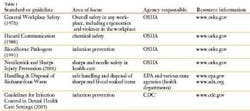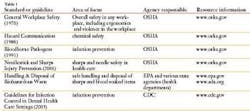Is it time for a safety checkup?
by Mary Govoni
As hygienists, we continually try to help our patients understand and value the importance of the preventive care visit. Prevention is our business. But when it comes to safety in our facilities, we don't necessarily take the same proactive approach. Do you know if your practice or work facility has a safety plan? Do you know when it was last updated? Is there a staff member in your facility who is responsible for managing the safety plan?
Let's assume that you don't know the answers to the above questions. If that is the case, you may have additional questions such as: What exactly is a safety plan, and what should it include? What are the occupational safety issues that a dental practice setting should be concerned about?
As defined by the Occupational Safety and Health Administration (OSHA), occupational safety issues in dentistry include: infection prevention, exposure to hazardous chemicals and physical hazards in the workplace, handling and disposal of biohazardous materials, workplace violence and ergonomics. Each of these safety hazards is addressed by OSHA safety standards and Centers for Disease Control and Prevention (CDC) guidelines. (see table 1)
OSHA safety standards are administered under federal or state jurisdiction. If you are not sure which category your state falls into, go to the OSHA website, www.osha.gov, and select the link "state partners" under "About OSHA." Selecting this link will open a page with a chart of all the states with OSHA plans. States not listed fall under federal jurisdiction. This is important, since state regulations may have special requirements for compliance not included in the federal safety standards.
All of the OSHA safety standards stem from the 1970 General Workplace Standard. This set of occupational safety rules has very broad application to all workplaces. The key element in the General Workplace Safety Standard is the "general duty clause." This provision in the standard requires all employers to provide "a place of employment free from recognized hazards that are causing or are likely to cause death or serious physical harm to his employees..." These safety hazards may include issues of electrical safety, tripping hazards, equipment handling, violence in the workplace, infectious disease, exposure to chemicals, ergonomics, and many other potential threats to worker safety.
In special cases that are applicable to dentistry or health care settings, such as infectious disease transmission and exposure to hazardous chemicals, OSHA has promulgated additional standards to address more specific safety issues. These issues are addressed in the Bloodborne Pathogens, the Hazard Communication, and the Needlestick and Sharps Injury Prevention Standards. Dental practice facilities should have copies of these three standards available for employees to review. Copies may be obtained from OSHA Web site (federal or state).
The OSHA safety standards require that an employer appoint a manager to oversee implementation and enforcement of safety standards in the workplace. In some dental practices, the employer assumes this responsibility; in others, it is delegated to an employee. In an educational setting or large facility, this responsibility is often delegated to an administrative employee.
A problem private practice settings face is finding an employee with the interest and time to commit to familiarizing themselves with the standards, required documentation and employee training, and the motivation to implement the requirements. Another challenge for dental practices is finding the information and resources to know what must be implemented in order to be in compliance with the various standards and guidelines. Several resources are listed in table 2.
In general, OSHA safety standards require training for employees to familiarize the employees with safety hazards and prevention of injury from exposure to the hazards. In the case of the Bloodborne Pathogens Standard, annual training updates are also required. The new CDC Infection Control Guidelines for Infection Control in Dental Health Care settings also recommend including administrative (business) staff in infection control training, along with the clinical staff. The resources listed in table 2 have training materials that can be utilized for in-office training or the practice can hire an outside trainer or consultant to conduct safety training for employees.
The Bloodborne Pathogens and Hazard Communication Standards also require that employers have written safety plans, which must be reviewed and updated annually. The Needlestick and Sharps Injury Prevention Standard requires that an annual meeting be held to review the incidence of sharps injuries and to evaluate safety devices for application and use in the practice. These safety plans are essentially narratives about the types of hazards employees may encounter in the workplace and safety precautions that must be taken to minimize or eliminate the hazards to prevent injuries from occurring. Again, the resources listed in table 2 have information and/or templates that can be utilized for drafting safety plans that are specific to your employment setting.
the incidence of sharps injuries and to evaluate safety devices for application and use in the practice. These safety plans are essentially narratives about the types of hazards employees may encounter in the workplace and safety precautions that must be taken to minimize or eliminate the hazards to prevent injuries from occurring. Again, the resources listed in table 2 have information and/or templates that can be utilized for drafting safety plans that are specific to your employment setting.
Conducting a safety audit in your practice setting is another method of ensuring compliance with safety standards. Table 3 lists some common safety hazards that may be found in dental offices and methods of eliminating or minimizing them. In addition to conducting safety audits, adding safety topics and updates to staff meeting agendas is a good method of keeping up to date.
Unfortunately, for some hygienists and in some practice settings, safety is an afterthought. Until and injury occurs or a team member contracts an infectious disease as a result of a work exposure, workplace safety is often taken for granted. Take a good look around your work setting. Is it time for a safety check-up?
Mary Govani, CDA, RDH, MBA, is the owner of Clinical Dynamics, a consulting company based in Michigan. She is a memeber of the Organization for Safety and Asepsis Procedures and is a featured speaker on the ADA Seminar Series. She also writes a column for Dental Equipment & Materials magazine. She can be contacted at [email protected]



